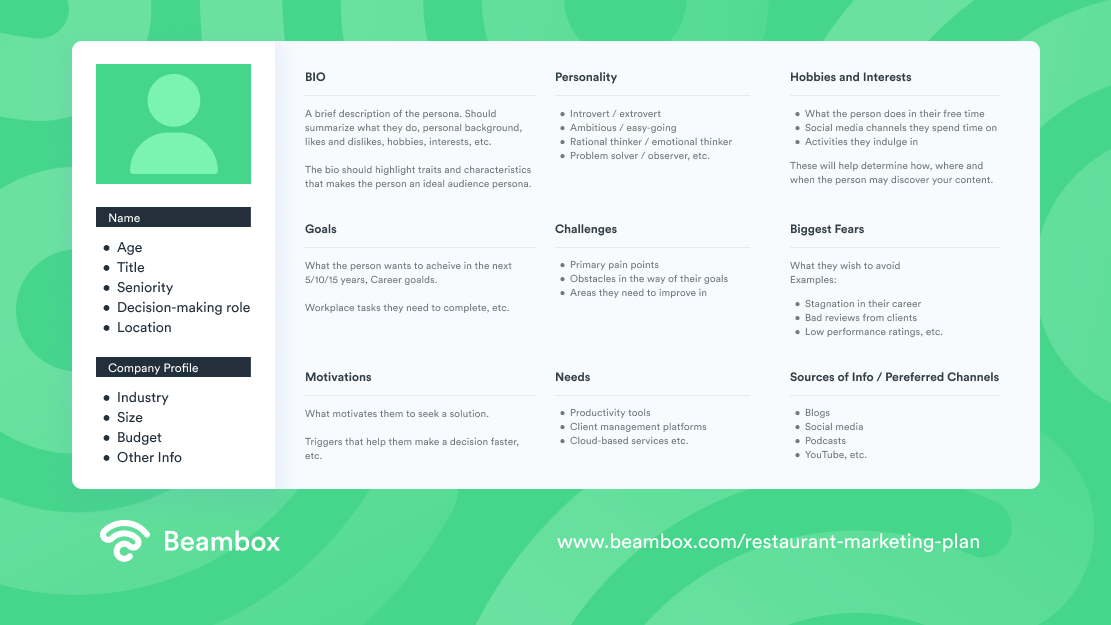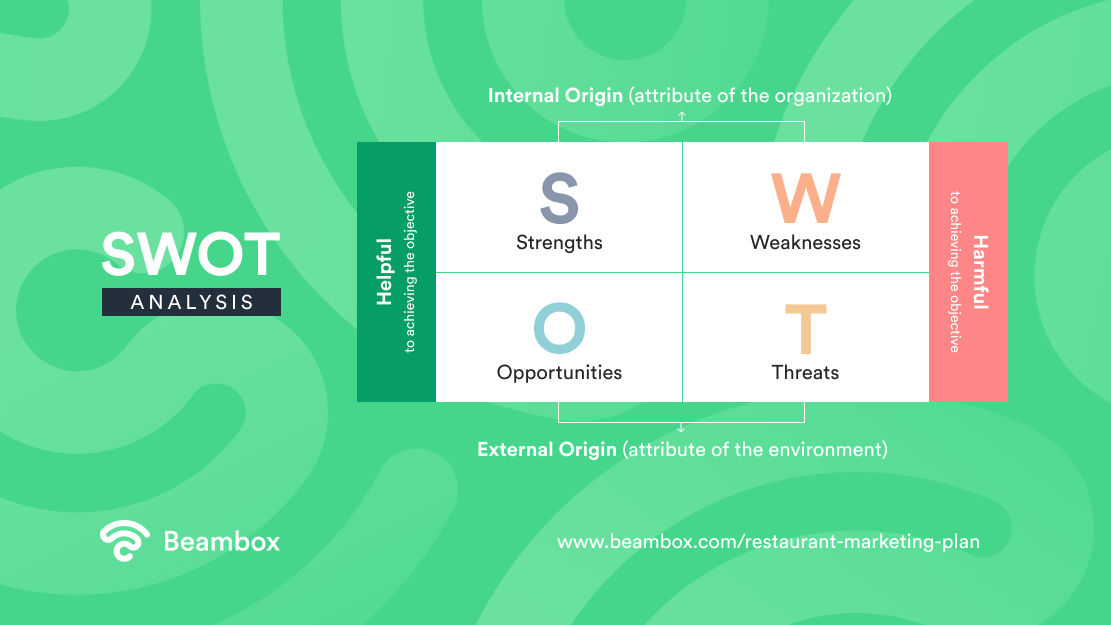In order to succeed in the hospitality market, you need a strategy that considers your customers, your strengths, and is based on a realistic view of your competitive context.
A restaurant marketing plan is an ideal tool for that. It helps you to reach your business goals through a scientific and measurable approach.
In this article, you will learn how to make an effective restaurant marketing plan that will make your business stand out from the crowd, attract new customers and reach any (realistic) business goal.
Moreover, at the bottom of the article, you will find a link to download your free restaurant marketing template.
Let’s start.
What Is a Restaurant Marketing Plan and Why Do You Need One
When it comes to restaurant marketing, setting up a plan means identifying a strategy that helps you reach your business’s goals through marketing initiatives.
In the marketing plan for your restaurant, you will clearly see any entity that makes your target market as well as any relevant element of your business.
In other words, you will define where you stand and where you want to go. Additionally, you will identify the obstacles and the opportunities that stand in the way.
Without a restaurant marketing plan, you will be in a position of weakness as you might act only by following intuitions or the trends of the moment.
While following intuition is not necessarily bad, a structured and measurable approach is necessary to make profitability and growth something you can replicate, and not an act of randomness.

How to Make a Restaurant Marketing Plan
The whole point of a restaurant marketing plan is to help you reach your business goals.
However, in order to get where you want to go, you first need to understand where you are.
The steps to creating a marketing plan are relatively simple. Just like creating a diet plan.
The hardest part, instead, is to follow the actions that result from the plan and measure them.
In fact, a marketing plan is not set in stone. It can be reviewed and edited anytime you gather new information, your market change or your business goals evolve.
A restaurant marketing plan follows 5 steps:
- Setting your goals
- Identify your ideal clients
- Research your competition
- Business identity and SWOT analysis
- Set up actions and follow up
Let’s go through them.
Restaurant Marketing Plan: Set Your Goals
A restaurant marketing plan is a tool that supports a restaurant to reach specific goals by creating an effective and measurable course of action.
Your goals might come from your business plan or any other relevant document. Regardless of the source, the first thing you need to do is state the results you want to achieve.
There are multiple ways to set your business goals, however, it is important that your objectives are clear, measurable, and realistic.
In fact, it would be useless to state “I want to make more money” or “The goal of my restaurant is to reach more clients and make them happy”.
None of these statements can help, because you won’t get a clear and measurable idea.
To set up clear and measurable goals, instead, you can use the SMART method.
SMART stands for: Specific, Measurable, Achievable, Realistic, and Timely.
Goals stated following this method give you a clear vision of where you want to go, and how you can measure if your actions are successful.
To make some examples, your business goals might be:
- Get 10 reviews on Google My Business every month
- Increase net profit margin by 1% by the end of the year
- Grow table profit by 10% by the end of the year
- Run a monthly event with $X of revenues
- Increase bookings through Facebook by 20%
Does it make sense?
Let’s move on to the next step of a restaurant marketing plan.
Restaurant Marketing Plan: Define Your Target Market and Ideal Clients
Creating a restaurant marketing plan continues with understanding your customers.
The math is simple: to reach your goals, you need happy customers. To make your customers happy, you need to understand their needs and desires.
This simple aspect is often overlooked by business owners, as they dedicate much more effort to improving their business based on what they like. However, this is a blind approach to business.
Is like going to fish and using strawberries as bait. Is that gonna work? Of course not. Because you might like strawberries, but fish don’t.
Although this metaphor might sound harsh, you don’t want to use a blind approach with your restaurant. You have to offer your customers what they like and desire.
The best tool to get this understanding is to make your buyer persona.
A buyer persona is a description of your ideal customers that lists various characteristics.

There are a few key elements that go into creating a buyer persona. You need to include things like their age, gender, location, and interests.
Additionally, and most importantly, you want to understand your customer’s needs, values, and desires.
For example, you might find out that your ideal customers are millennials, who care about the environment, and want to eat well but they also care about sharing their experiences on Instagram.
With this understanding, you might want to reduce the amount of plastic in your restaurant and tell your chef to create beautiful meals that deserve a picture.
You can make one or more buyer personas. It depends on your typical customer base.
The important thing to understand is that, once you understand your customers, you can offer them what they expect and value.
Moreover, you can develop messaging and communications that will resonate with them.
Research Your Competition
When creating a restaurant marketing plan, you can’t ignore researching your competition.
Researching your competition will give you an idea of what they are doing well, what you can improve upon, and how you can differentiate yourself.
To start, create a list of your top competitors.
Then, visit their websites and social media pages. Notice their menu offerings, prices, and any promotions or specials they are running.
Also, check their marketing initiatives and what people say about them on local review sites. This will help you get a better feel for their atmosphere and service.
You should not spend too much time on this step, however. The point of this research is not to copy your competitors, but rather to understand what they are doing right and wrong, as well as what they are not doing.
By taking the time to research your competition, you will be able to implement actions and initiatives that will help your restaurant stand out from the crowd.
Restaurant Marketing Plan: Business Identity and SWOT Analysis
After you identified your ideal customers and researched your competitors, it’s time to have a 360° look at your business.
Your restaurant marketing plan cannot lack a clear definition of your business identity, as well as an analysis of your strength and weakness.
Your business identity represents what your brand represents and what values it embodies.
Your business identity is an important part of a restaurant marketing plan as it makes your decision process much easier.
Anything in your business should match your business identity. And your business identity should match customers’ values and expectations.
Imagine a Vegan food truck that caters to carnivores. That is an incoherent brand identity that does not appeal to their supposed ideal customers.
Along with your business identity, you have to look at your restaurant within its context.
This type of analysis is typically conducted with a SWOT matrix. SWOT stands for Strengths, Weaknesses, Opportunities, and Threats.
A SWOT analysis requires you to identify your unique selling points (USPs) and strengths as well as your weaknesses. Consider what makes your restaurant unique and its downsides.
Moreover, considering the previous points of your marketing plan (ideal customers and competitors), you want to list the opportunities in your market as well as any threats.

Fill any square of the SWOT matrix with your considerations about your business and be honest with yourself.
Restaurant Marketing Plan: Reach Out to Your Customers
At this point, your restaurant marketing plan is providing you with enough information to set up a course of action.
Now it’s time to identify where your customers congregate, how you want to communicate with them, and how you are going to attract and retain them.
The typical set of actions involves:
-
Social Media and SEO
- The internet is a powerful channel to win new customers. Consider creating a user-friendly and SEO-optimized website for your restaurant. Additionally, take care of your restaurant’s social media pages and create engaging contents that reflect your business identity.
-
Local Review Sites
Restaurants can dramatically change their profitability depending on what people write about them on local review sites. Be sure to pick the best local review sites for restaurants and cultivate your presence there.
-
Offline initiatives
Your restaurant is a physical location, therefore you need to get proactive and implement initiatives that win new customers and grow loyalty toward your business. These might be events, seasonal pricing strategies, loyalty programs, and more.
-
Review your venue
You might need to rethink something within your restaurant. This might be something simple (updating your menu) or something more profound (reviewing a business process that does not help to reach your goals)
It is fundamental that all your communications, whether online or offline, reflect your brand identity and match your customer’s expectations.
Moreover, prioritize your effort according to your goals.
If, for example, one of your goals is growing your rating on Yelp, setting up a process for getting more reviews on Yelp is of primary importance.
To complement these activities, you might want to resort to advertising.
Depending on your goals (and where your customers congregate), you might prefer to advertise online or offline. However, create a budget and stick to it. This will make you able to track your spending and ensure that your ads are reaching their goal.
Example of a Restaurant Marketing Plan
Let’s see an example of a restaurant marketing plan.
Imagine Bill. A business owner that runs a restaurant somewhere in the US.
Following the restaurant marketing plan template at the bottom of this article, Bill set simple and measurable goals for his business:
- Grow his rating on TripAdvisor beyond 4
- Increase net profit margin by 1% by the end of the year
- Run an event each quarter, with $2000 of revenues
Bill identifies their ideal customers as middle-class families with kids, who look for a relaxing place for dining and are attentive to the quality of their meals.
There are a few restaurants that target similar clients but no one with specific offers and plans.
In his SWOT analysis, Bill identifies as strengths the quality of the meals, the large parking lot on his property, and the space available in his venue.
However, the furniture is slightly outdated and, among his staff, no one is good with social media.
After checking online, Bill realizes that no restaurant presents specific events or offers for families, so Bill decides to take advantage of it.
The actions that Bill will implement to reach his goals are:
- Setting up a process for getting reviewed on TripAdvisor
- Running events during bank holidays that target specifically families with kids
- Set up a loyalty program specifically for families
- Review the restaurant menu with fewer items but focused on families’ needs
- Invest in an outdoor playground with fences
- Hire a freelancer to handle social media and run ads to target families
Over time, Bill will need to track his marketing effort and verify that he’s reaching the goals established in his restaurant marketing plan.
Free Restaurant Marketing Plan Template
If you want to follow this marketing plan for your restaurant, there’s a gift for you.
Here is a free restaurant marketing plan template that goes through the process you just read.
Also, to complement your marketing effort, check out Beambox.
Beambox is an all-in-one WiFi marketing solution that allows you to connect, capture data, and learn more about your customers and their preferences.
There are over 12,000 venues that are taking advantage of Beambox to collect data from their real customers, measure their results, and redirect their marketing efforts.
Start your Beambox 30-day free trial today.
Get Started With Free WiFi Marketing
Beambox helps businesses like yours grow with data capture, marketing automation and reputation management.
Sign up for 30 days free